|
How
Cleveland Diesel Answered the Call
Cleveland Diesel Division of General Motors Corporation in World War
Two
Cleveland, OH
1897-1962
Originally the Winton Motor Carriage Company
Rest in Peace
This page updated 10-30-2018.
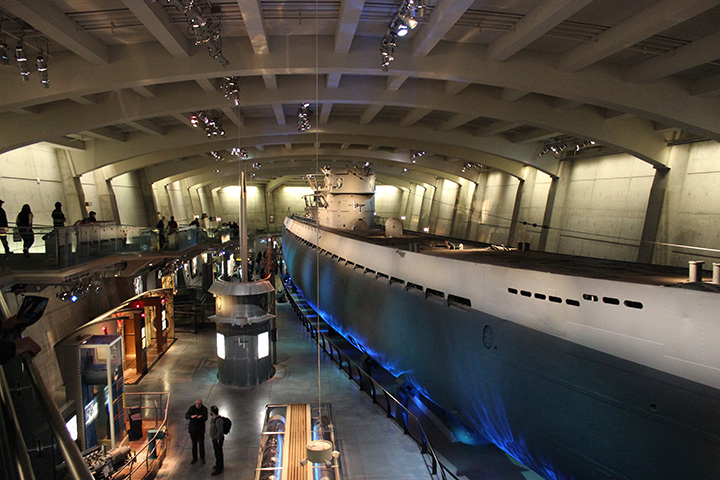
Why is the German U-Boat U-505 the first
photo on this page for the Cleveland Diesel Engine Division of General
Motors? Because the Fleet Tug USS Abnacki, powered by four
Cleveland Diesel 12-278A main engines, towed this U-Boat across the Atlantic Ocean,
from Africa to Bermuda, after its capture by US Naval Forces in World
War Two.
Thanks to the Cleveland Diesel 12-278A
engines, millions of persons have been able to visit and tour the U-505
at the Museum of Science and Industry in Chicago. Author's photo.
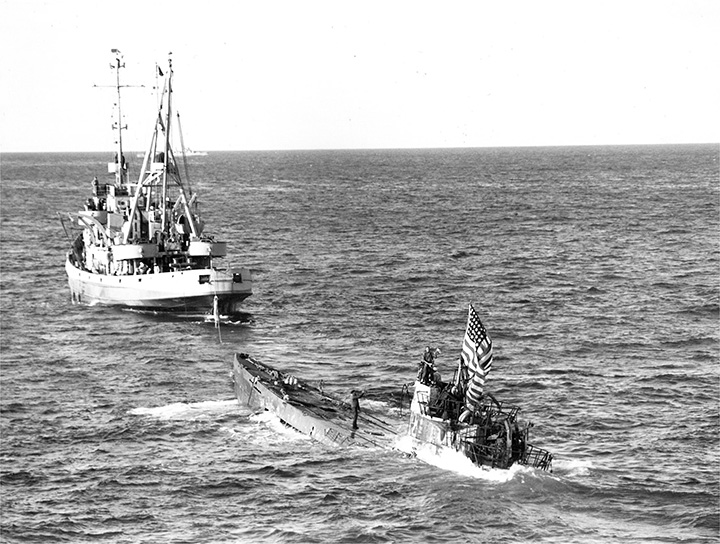
The USS Abnacki has the U-505 under tow
across that Atlantic Ocean, en route to Bermuda.
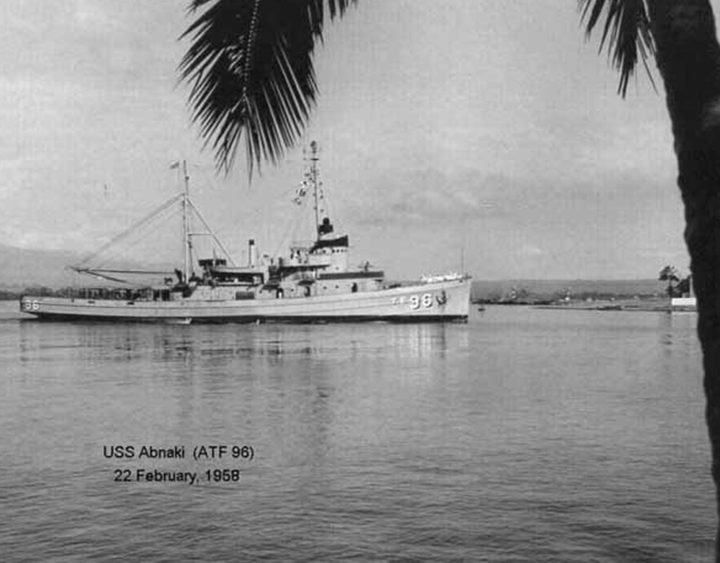
The USS Abnacki was the lead ship for the twenty two Abnaki Class fleet
tugs, all powered by Cleveland Diesel 12-278A engines. Each engine
had 12 cylinders, with 631 cubic inches; totaling 7,572 cubic inches
total displacement.
History: Alexander Winton started the
Winton Bicycle Company in Cleveland, OH in 1890. Seven years later
he formed the Winton Motor Carriage Company, producing motor vehicles
until 1924. After that, Winton focused on both gasoline and diesel
engine manufacture. In 1930 General Motors purchased Winton for
its diesel engine expertise, and formed the Winton Engine Corporation, a
wholly owned subsidy of GM. Winton Engine designed and built the
first railroad diesel engines for General Motors, which were used to
start a new GM Division that built railroad diesels and locomotive, the
Electromotive Division. In 1937, GM made Winton Engine into
a division of GM, the Cleveland Diesel Engine Division. Its
engines focused mainly on marine applications. Its diesel engines
were used during World War Two for both main propulsion and auxiliary power sources
in many types of ships for the US Navy.

This very rare 1899 Winton is on display at
the Ohio History Center in Columbus, OH. Author's photo.
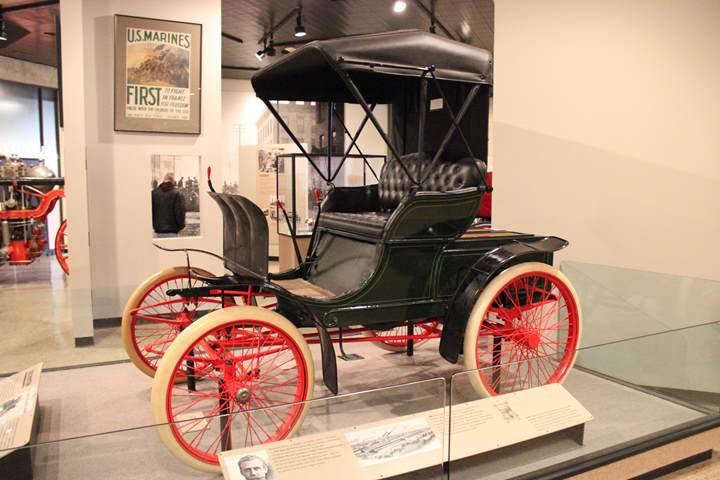
This is one of more than 100 vehicles
that Winton sold in 1899, making it the largest manufacturer of vehicles
in the U.S. for that year. Author's photo.
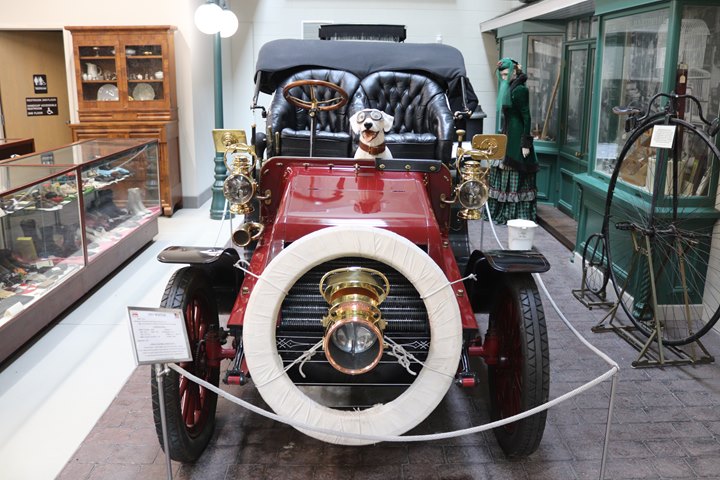
Four years later the Winton Motor Carriage
Company produced this 1903 Two-Chair Runabout. Notice how quickly
the design technology of the automobile changed in four years. It
is on display the the LaPorte County Historical Society Museum in
LaPorte, IN, and is one of several rare vehicles on display at this
museum. Author's photo added 10-30-2018.
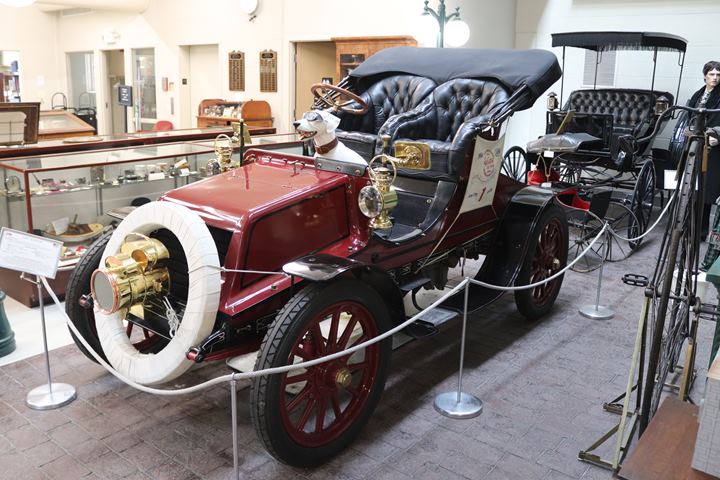
Author's photo added 10-30-2018.
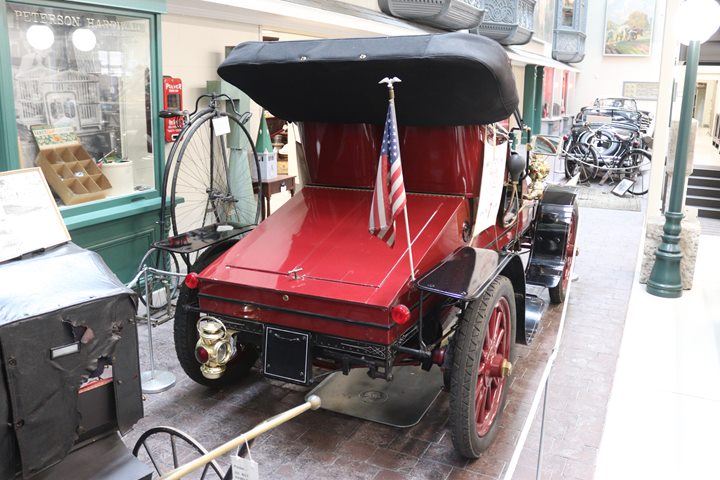
Author's photo added 10-30-2018.

The Cleveland Diesel Division of General Motors won the Army-Navy "E" Award six times.
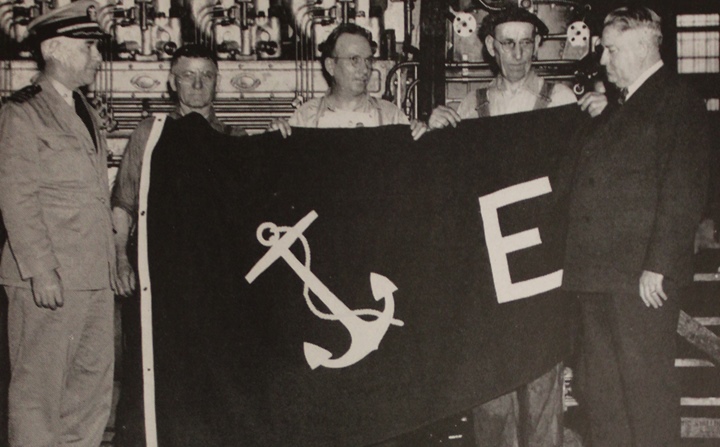
The Cleveland Diesel Division won the Navy "E" Award on May 15, 1942.
The Cleveland Diesel Division converted to the Army-Navy "E" flag for
its next awards.
The Cleveland Diesel Division won its second award on November 15, 1942.
The Cleveland Diesel Division won its third award on May 15, 1943.

The Cleveland Diesel Division won its fourth award and third star
on November 15, 1943.
Cleveland Diesel Division of GM
World War Two Products: The Division built at least 8,920
diesel engines as shown below. The Division also had
$1,175,899,000 in major contracts during World War Two.
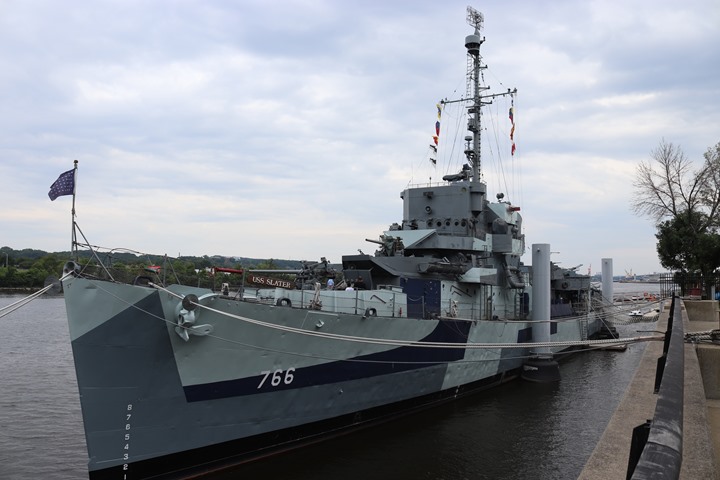
The USS Slater is the only Cannon Class
Destroyer Escort on display in the world, and is located on the Hudson
River in downtown Albany, NY. It had four Cleveland Diesel Diesel
engines driving generators which provide power to four electric motors
for main propulsion, and four more for
ship's electrical power. Author's photo added 10-29-2017.
|
Cleveland Diesel Powered Ships - World War Two |
| Class of ship |
Number in Class
with Cleveland Diesel Engines |
Cleveland Engine Type |
Number of engines
per ship |
Total Engines |
Comments |
| Abnacki ATF-96 to ATF-117 |
22 |
(4) Cleveland Diesel 12-278A diesel main
engines and (3)
Cleveland Diesel 3-268A auxiliary services
engines |
7 |
154 |
4 × General Electric generators single screw |
| 110 Foot Sub
Chasers SC-497 class |
195 |
Cleveland
Diesel 8-268A |
2 |
390 |
243 of the class used the
GM Electro-Motive pancake engine |
| Auxiliary Motor
Minesweepers YMS |
481 |
Cleveland
Diesel 8-268A |
2 |
962 |
|
| Evarts Class
Destroyer Escort |
97 |
See Below |
7 |
776 |
Four main
propulsion and three service engines each |
| Cannon Class
Destroyer Escort |
72 |
See Below |
7 |
576 |
Four main
propulsion and three service engines each |
| Landing Ship
Medium |
61 |
See Below |
4 |
244 |
|
| Landing Ship
Medium (R) |
58 |
See Below |
|
|
|
| FS US Army
Coastal Freighters |
318 |
500hp
6-278A V6 |
2 |
636 |
Twin Screws |
| All Submarine
Classes |
136 |
See Below |
4 |
1,648 |
|
| Total ships |
1,440 |
|
Total engines |
5,444 |
|
|
Cleveland Diesel Powered Evarts Class Destroyer Escorts - World War Two |
| Class of Ship |
Number in Class |
Cleveland Engine Type |
Number of engines
per ship |
Total Engines |
Comments |
|
Evarts Class DE |
97 |
Cleveland Diesel Model 16-278A, 16 cylinder, main
propulsion engines with electric drive |
4 |
388 |
Twin Screw |
| |
|
Cleveland
Diesel Model 8-268A, 8
Cylinder, 350 HP for ship's electrical service |
2 |
194 |
|
| |
|
Cleveland
Diesel Model 3-268A, 3
Cylinder, 150 HP for emergency ship's electrical service and
while docked |
2 |
194 |
|
|
Totals |
97 |
|
|
776 |
|
|
Cleveland Diesel Powered Cannon Class Destroyer Escorts - World War Two |
| Class of Ship |
Number in Class |
Cleveland Engine Type |
Number of engines
per ship |
Total Engines |
Comments |
| Cannon
Class DE |
72 |
Cleveland Diesel Model 16-268A, 16 cylinder, main
propulsion engines with electric drive |
4 |
288 |
Twin Screw |
| |
|
Cleveland
Diesel Model 8-268A, 8
Cylinder, 350 HP for ship's electrical service |
2 |
144 |
|
| |
|
Cleveland
Diesel Model 3-268A, 3
Cylinder, 150 HP for emergency ship's electrical service and
while docked |
2 |
144 |
|
|
Totals |
72 |
|
|
576 |
|
|
Cleveland Diesel Powered Landing Ship Medium (LSM) - World War Two |
| Class of Ship |
Number in Class
with Cleveland Diesel Engines |
Cleveland Engine Type |
Number of engines
per ship |
Total Engines |
Comments |
|
Landing Ship Medium (LSM) |
61 |
Cleveland Diesel Model 16-278A, 16 cylinder, main
propulsion engines with electric drive |
2 |
122 |
Twin Screw
Direct Drive |
| |
|
Cleveland
Diesel Model 8-268A, 8
Cylinder, 350 HP for ship's electrical service |
1 |
61 |
|
| |
|
Cleveland
Diesel Model 3-268A, 3
Cylinder, 150 HP for emergency ship's electrical service and
while docked |
1 |
61 |
|
|
Totals |
61 |
|
Total Engines |
244 |
. |
|
Cleveland Diesel Powered Landing Ship Medium (Rocket) (LSM-(R)) - World War Two |
| Class of Ship |
Number in Class
with Cleveland Diesel Engines |
Cleveland Engine Type |
Number of engines
per ship |
Total Engines |
Comments |
Landing Ship Medium
(LSM(R)) |
58 |
Cleveland Diesel Model 16-278A, 16 cylinder, main
propulsion engines with electric drive |
2 |
116 |
Twin Screw
Direct Drive |
| |
|
Cleveland
Diesel Model 8-268A, 8
Cylinder, 350 HP for ship's electrical service |
2 |
116 |
|
| |
|
Cleveland
Diesel Model 3-268A, 3
Cylinder, 150 HP for emergency ship's electrical service and
while docked |
1 |
58 |
|
|
Totals |
58 |
|
Total Engines |
232 |
. |
|
Cleveland Diesel Powered Submarines - World War Two |
|
Class of Submarine |
Number in Class |
Number with Cleveland Diesel Engines |
Type Cleveland Diesel Engines |
Number of engines
per ship |
Total Engines |
Names of boats with Cleveland Diesels in Class |
| P (Porpoise) |
10 |
10 |
Cleveland
Diesel 16-201A
diesel engines, 1,300 hp (970 kW) each, driving
electrical generators |
4 |
40 |
First use of
the Winton/GM Cleveland
Diesel engines in an American submarine. They were built from 1933 to 1937.
Porpoise, Pike, Shark, Tarpon, Perch, Pickerel, Permit, Plunger,
Pollack, Pompano |
| Salmon |
6 |
6 |
Cleveland
Diesel 12-278 |
4 |
24 |
The
six submarines were originally built and powered by four
Hooven-Owens-Rentschler (H.O.R.) Engines in 1936 to 1938.
In 1943 and 1944 the six Salmon Class submarines had their H.O.R.
engines replaced by Cleveland Diesel 12-278 engines. They
were:
Salmon, Seal, Skipjack, Snapper, Stingray, and Sturgeon
|
| Sargo
|
10 |
10 |
Cleveland
Diesel 12-278 diesel engines (two
direct drive, two driving
electrical generators), 1,535 hp each |
4 |
40 |
Built
in 1937 to 1939. The Squalus, Swordfish, Sealion,
and Seawolf originally were built with Cleveland Diesel 12-278
engines. The following
Sargo Class Submarines originally had Hooven-Owens-Rentschler (H.O.R.)
engines installed. They were replaced by GM 12-278A
engines in 1943 -1944. Sargo,Saury, Spearfish,
Scuplin, Seadragon, Searaven |
| Tambor |
6 |
3 |
Cleveland
Diesel 16-248 |
4 |
12 |
Three
of the six boats had GM Cleveland Diesel Engines. They
were: Tambor, Tautog and Thresher. The remaining
submarines had Fairbanks-Morse engines. |
| Gar
(These are a later group of Tambor Class submarines |
6 |
6 |
Cleveland Diesel 16-248 |
4 |
24 |
Three
of the
six in the class were powered by Cleveland Diesel Engines.
Gar, Grampus, Grayback
The remaining submarines had
Fairbanks-Morse engines. |
| Gato
Class |
77 |
44 |
Cleveland Diesel 16-248 main engines 1,600 HP
|
4 |
176 |
Forty-three
of the 77 in the Gato Class were powered by Cleveland Diesels. They
were:
Gato, Greenling, Grouper, Growler, Grunion, Guardfish, Barb,
Blackfish, Bluefish, Bonefish, Cod, Cero, Corvina, Darter,
Wahoo, Whale, Angler, Bashaw, Bluegill, Bream, Cavalla, Cobia,
Croaker, Dace, Dorado, Flasher, Flier, Flounder, Gabilan, Peto,
Pogy, Pompon, Puffer, Rasher, Raton, Ray, Redfin, Robalo, Rock,
Golet, Guavina, Guitarro, Hammerhead, Runner
Twenty of the 77 were lost in combat. |
| Balao |
120 |
61 |
Cleveland Diesel 16-278 |
4 |
124 |
Sixty-one of the 120 in the Balao Class were powered by
Cleveland Diesels.
Balao, Billfish, Bowfin, Cabrilla,
Capelin, Cisco, Crevalle, Perch, Shark, Sealion, Barbel,
Barbero, Baya, Becuna, Bergall, Besugo, Blackfin, Caiman,
Blenny, Blower, Blueback, Boarfish, Charr, Chub, Brill, Bugara,
Bullhead, Bumper, Cabezon, Dentuda, Capitaine, Carbonero, Carp,
Catfish, Entemedor, Chivo, Chopper, Clamagore, Clobber, Cochino,
Corporal, Cubera, Cusk, Diodon, Dogfish, Greenfish, Halfbeak,
Hardhead, Hawkbill, Icefish, Jallao, Kete, Kraken, Lagarto,
Lamprey, Lizardfish, Loggerhead, Macabi, Mapiro, Menhaden, Mero,
|
| Tench Class |
29 |
5 |
Cleveland Diesel 16-278 |
4 |
20 |
Five
of the Tench Class used used Cleveland Diesel engines.
They were the Tench, Turbot Corsair, Ulua, and Runner. |
|
Total |
|
136 |
|
|
1,648 |
|

The USS Evarts, the lead ship in the class of destroyer escorts by the
same name. The 97 in the class were all powered by four Cleveland
Diesel 16-278 engines.
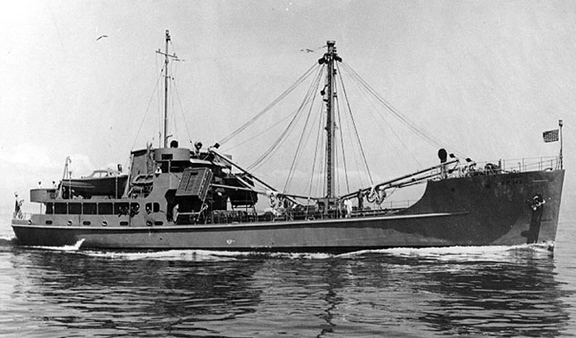
The 318 coastal freighters of the FS series
were built for the US Army by 25 different ship builders and were
powered by two Cleveland Diesel 500hp 6-278A V6 engines.
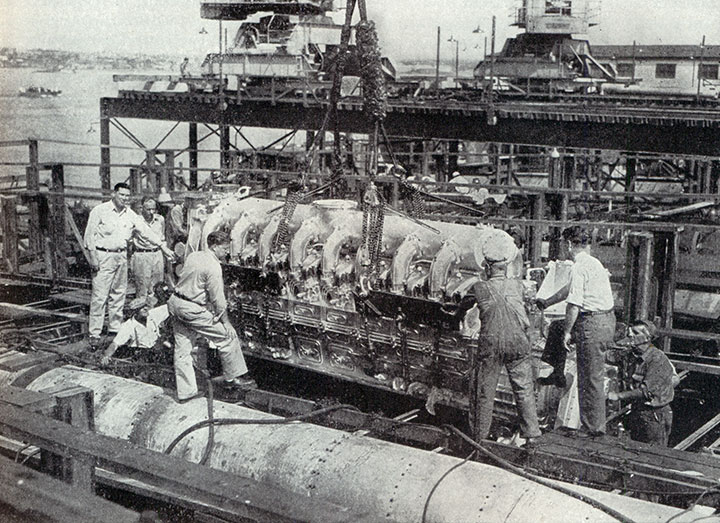
A Cleveland Diesel engine is being installed
in a U.S. submarine during World War Two.
USS Cod in Cleveland, OH:
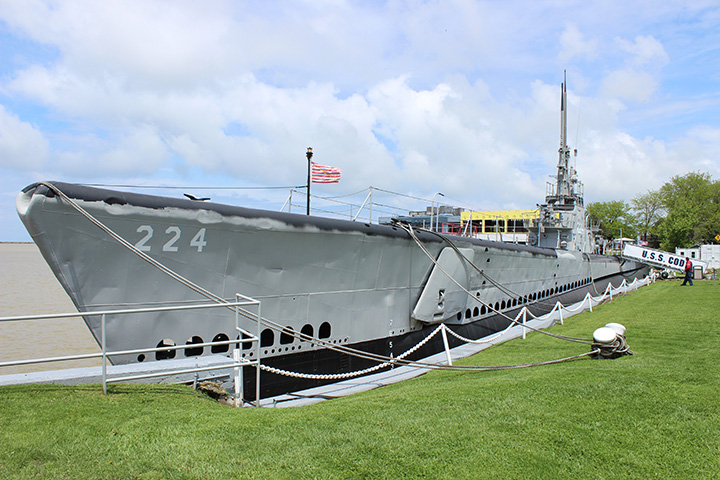
The USS Cod is on display in Cleveland, OH.
It is equipped with Cleveland Diesel engines, all of which are
operational. Author's photo.
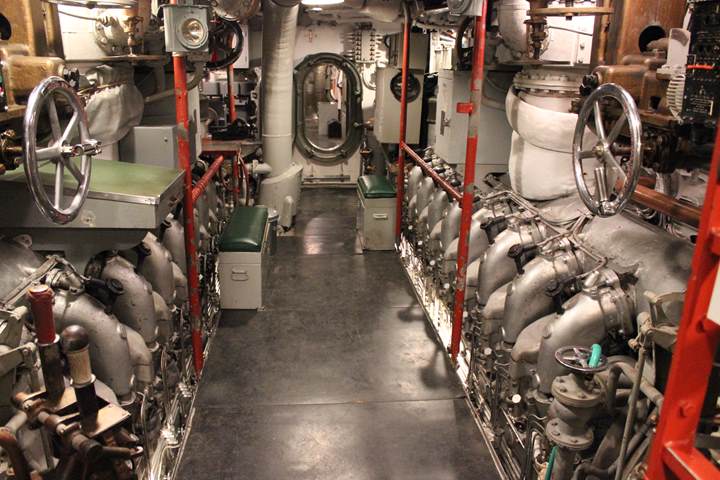
The tops of two 16-248 Cleveland Diesel
engines are visible in the aft engine room. Each of the sixteen
cylinders contains 596 cubic inches of displacement. The bottom
half of the engines are under the floor plates. Author's photo.
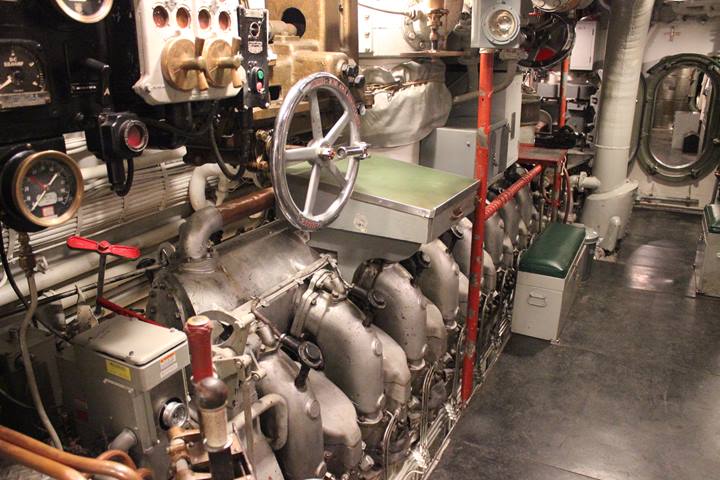
Author's photo.
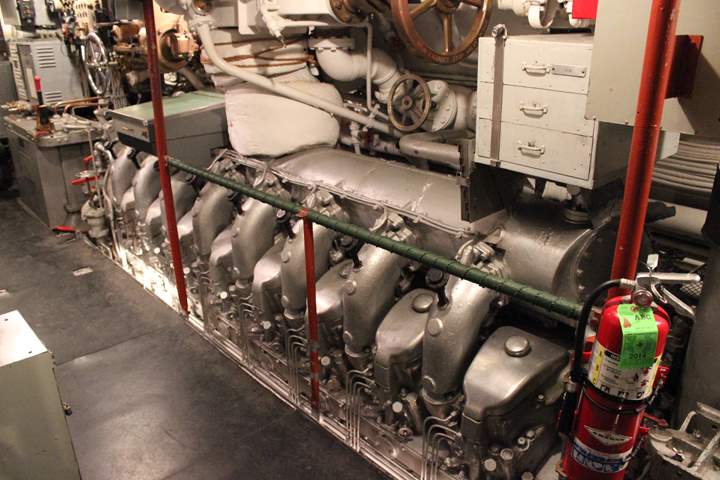
Author's photo.
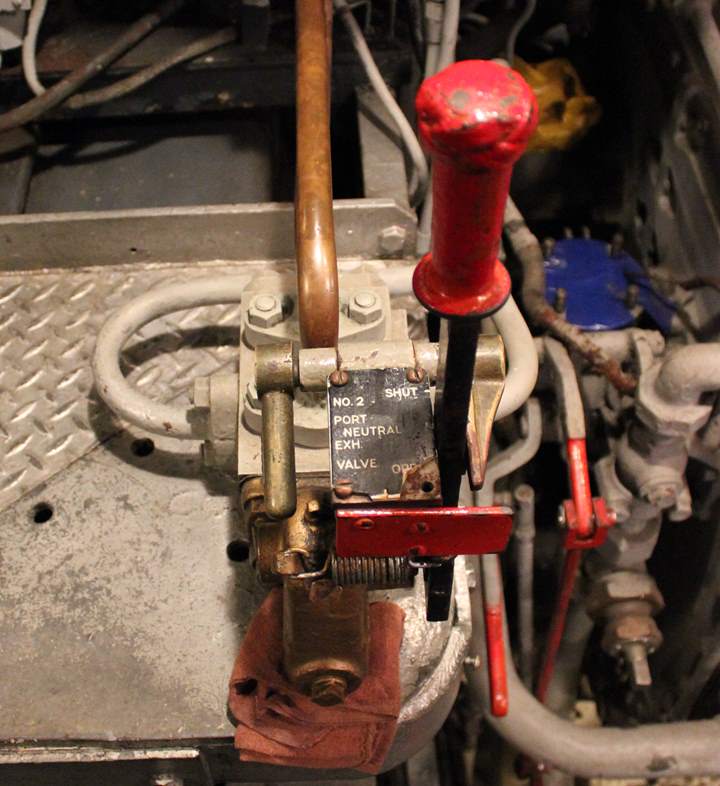
Author's photo.
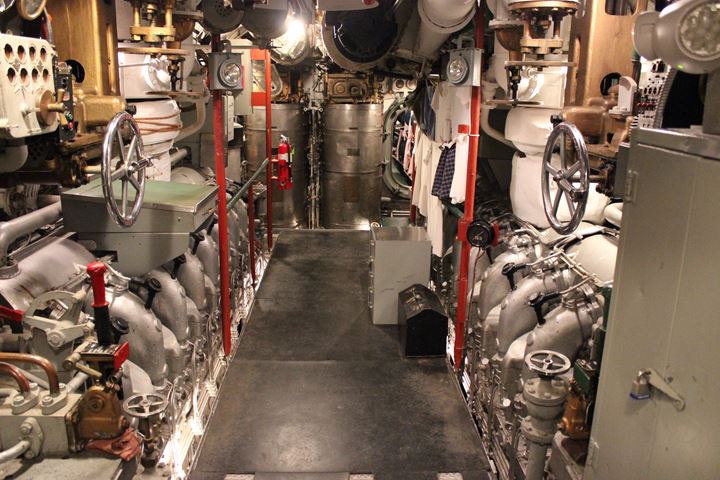
The forward engine room on the USS Cod. Author's photo.
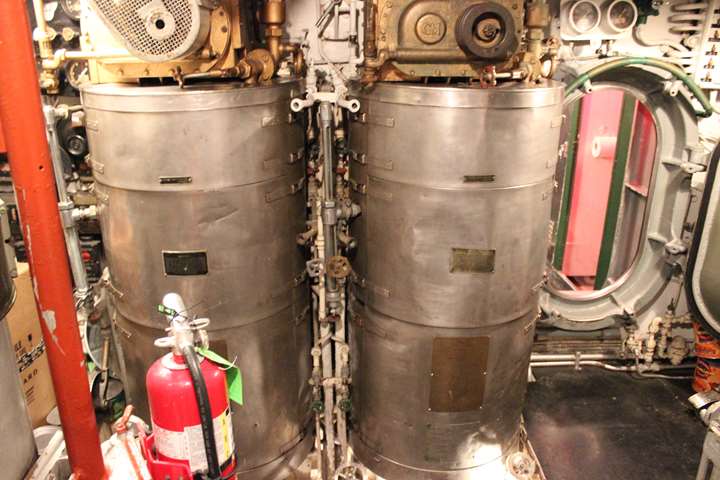
Water evaporators processed 1,000 gallons a day for
batteries and crew drinking. Author's photo.
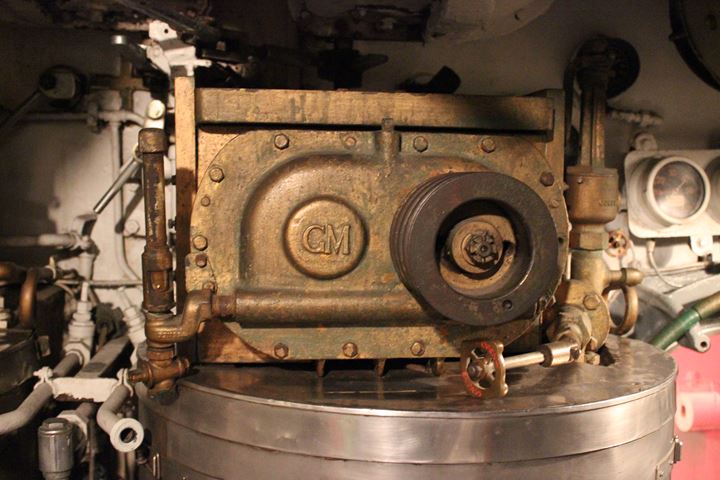
Author's photo.
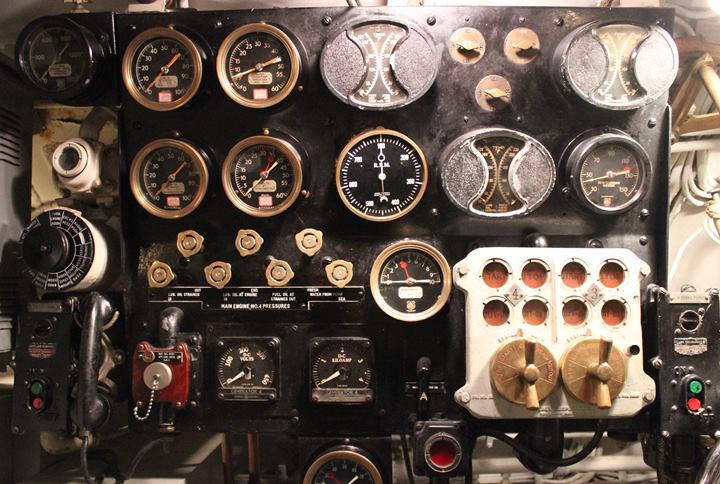
Author's photo.
The USS Slater DE-766 in Albany, NY:

Aft
Auxiliary
Motor Room B4: This
contains a Cleveland Diesel 3-268 150 HP emergency ship's service
generator
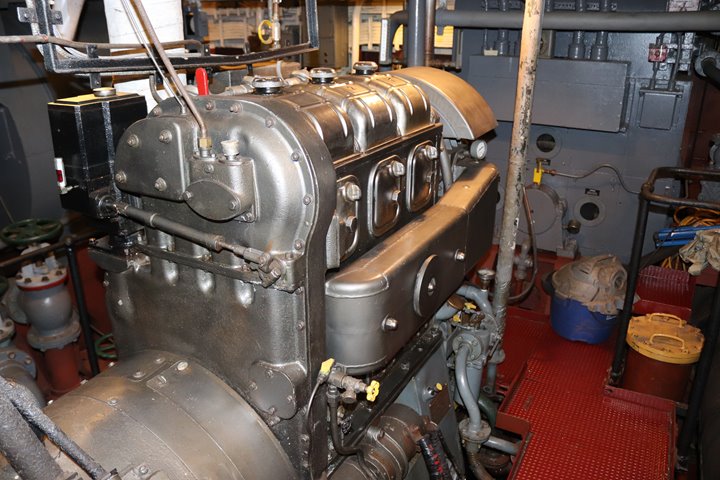
The Cannon Class Destroyer Escorts had one three cylinder Cleveland
Diesel 3-268 150 HP emergency ship's service generator in the aft motor
room B4. Author's photo added 10-29-2017.
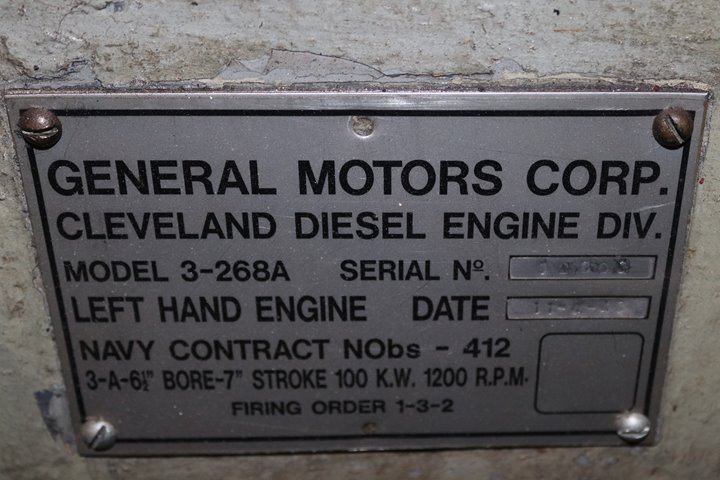
The serial number is 12803, and the date of manufacture is 11-4-1943. Author's photo added
10-29-2017.
Aft Engine Room B3: This contains
one Cleveland Diesel 8-268 for the ship's electrical service generator,
and two Cleveland Diesel 16-268 main propulsion engines. The main
propulsion engines each drive an Allis-Chambers electric generator.
The power produced by the generators operates two 1,500 hp Westinghouse
electric motors in tandem that drive the port side propeller.
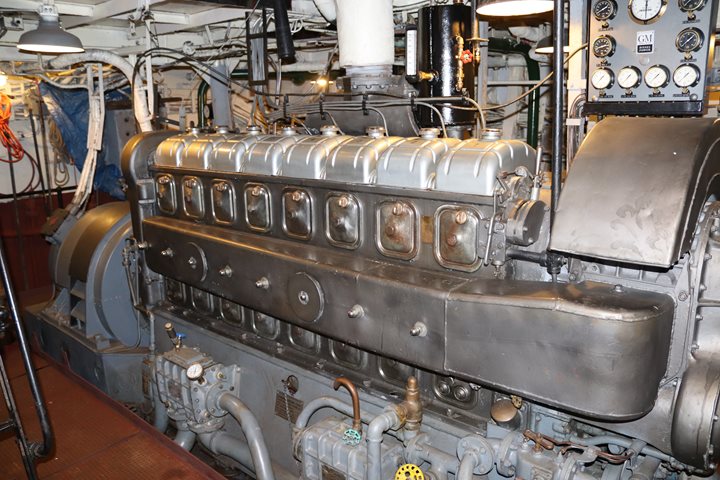
The Cannon Class Destroyer Escorts had two
eight cylinder Cleveland Diesel 8-268 for the ship's electrical service
generators. This one is in the aft motor room B4. Author's photo added
10-29-2017.
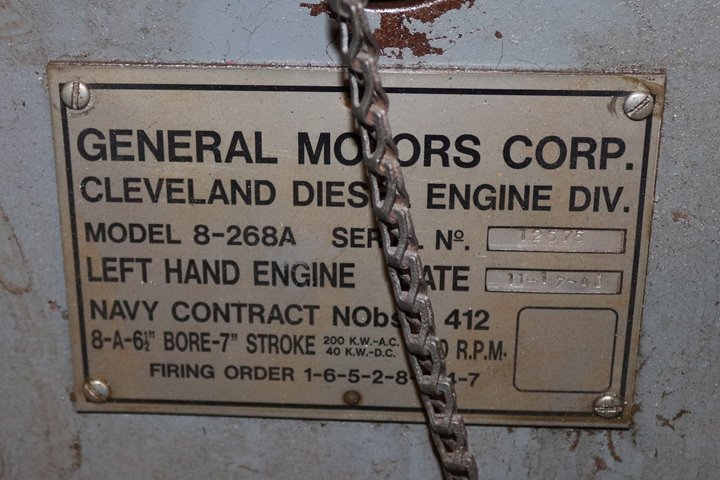
The serial number is 12575, and the date of manufacture is 11-17-1943. Author's photo added
10-29-2017.
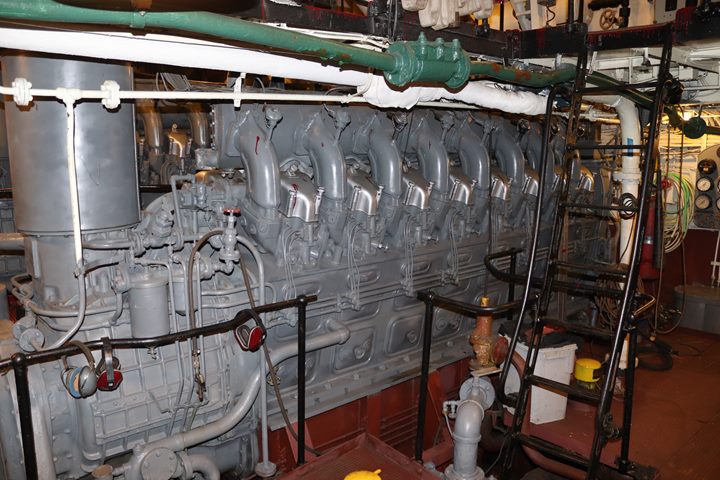
This is the Cleveland Diesel 16-268 main
propulsion engine #3 on the USS Slater. This is looking aft with
the big air intake at the left of the photo. Engine #4 can seen
behind engine #3. Author's photo added 10-29-2017.
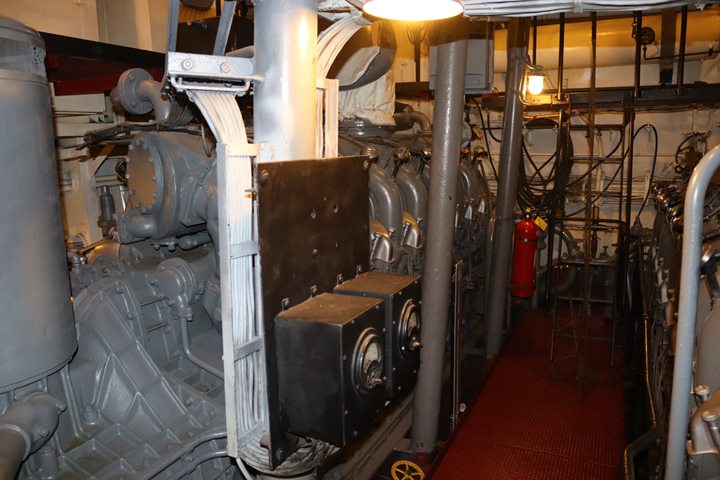
Engine #4 is on the left, and engine #3 is
on the right. Author's photo added 10-29-2017.
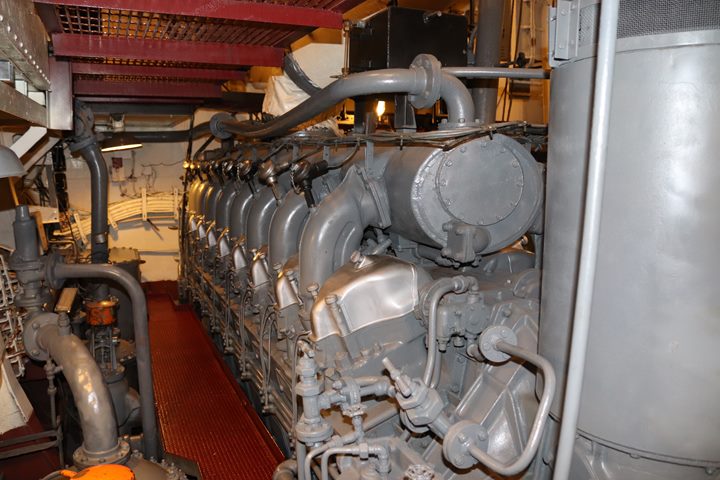
Looking along the starboard side of engine
#4. Author's photo added 10-29-2017.
Forward Engine and Motor Rooms:
The forward engine and motor rooms have not yet been restored and are
not as well lit as the aft rooms. A comparison of the photos of
the forward and aft rooms show the the tremendous amount of work that
hard working volunteers of the USS Slater have done to restore the aft
rooms to their present condition. This has taken thousands of
hours of labor to do this.
Forward Auxiliary
Motor Room B2: This contains a Cleveland Diesel 3-268 150 HP
emergency ship's service generator
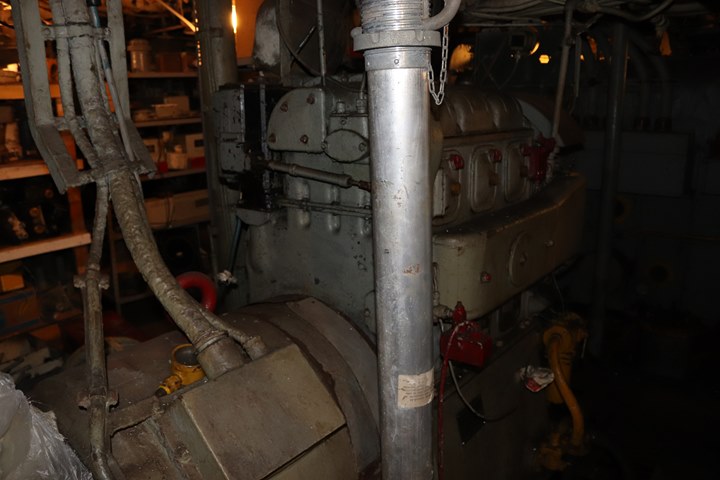
The Cannon Class Destroyer Escorts had one three cylinder Cleveland
Diesel 3-268 150 HP emergency ship's service generator in the forward
motor room. Author's photo added 10-29-2017.
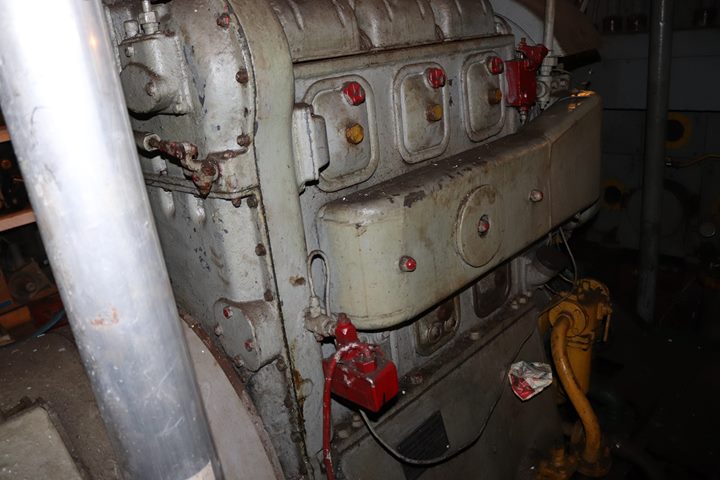
In the darkness I missed the data plate on the engine. Author's photo added
10-29-2017.
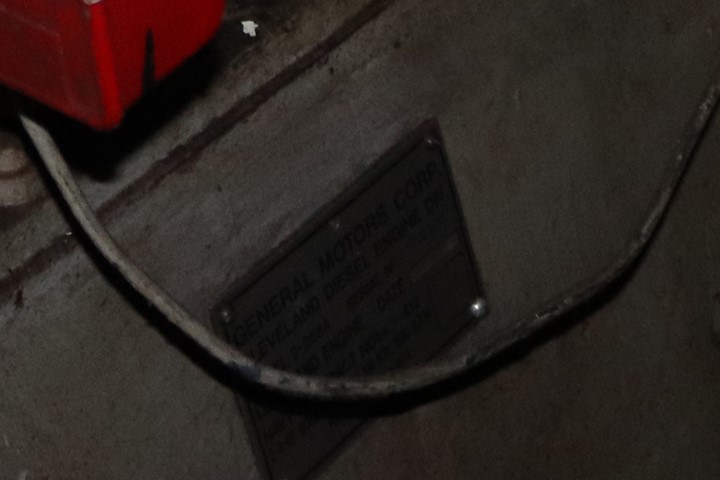
While the serial number and date of manufacture are not visible, this
photo shows it is a Cleveland Diesel 3-268 left hand engine similar to
the one in the aft motor room. Author's photo added 10-29-2017.
Forward Engine B1:
This contains one Cleveland Diesel 8-268 for
the ship's electrical service generator, and two Cleveland Diesel 16-268
main propulsion engines. The main propulsion engines each drive an
Allis-Chambers electric generator. The power produced by the
generators operates two 1,500 hp Westinghouse electric motors in tandem
that drive the starboard side propeller.
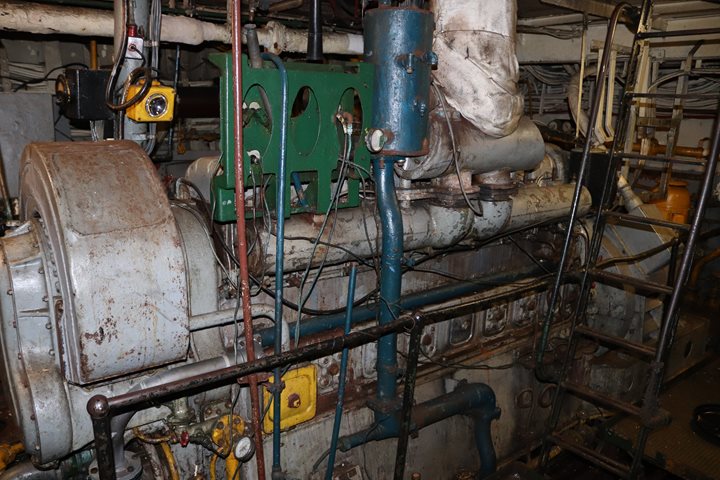
This is the un-restored eight cylinder Cleveland Diesel 8-268 electrical
service generator in the forward motor room. There was no visible
data plate for it. Author's photo added 10-29-2017.
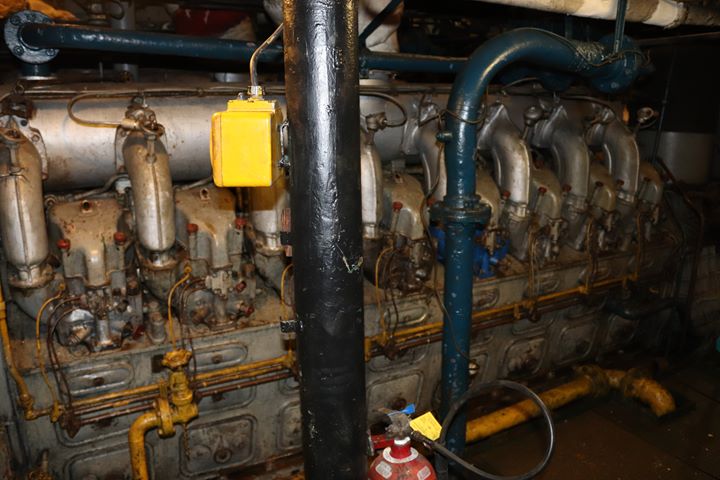
This is the un-restored sixteen cylinder Cleveland Diesel 16-268 main
propulsion engine #2 in the forward engine room. There was no
visible data plate for it. Author's photo added 10-29-2017.

This is another photo of engine #2. The air intake for the engine
is in the upper right hand corner and is the front of the engine. Author's photo added
10-29-2017.
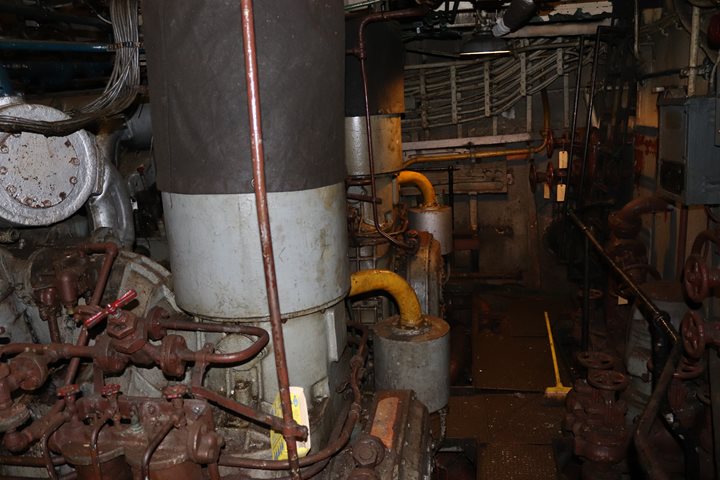
Both air intakes are visible for the forward
engine room main propulsion Cleveland Diesel 16-268s. Number two
is the nearest intake. Author's photo added 10-29-2017.

Looking aft this shows the small amount of space between #2 main
propulsion engine on the left, and #1 main propulsion engine on the
right. Author's photo added 10-29-2017.
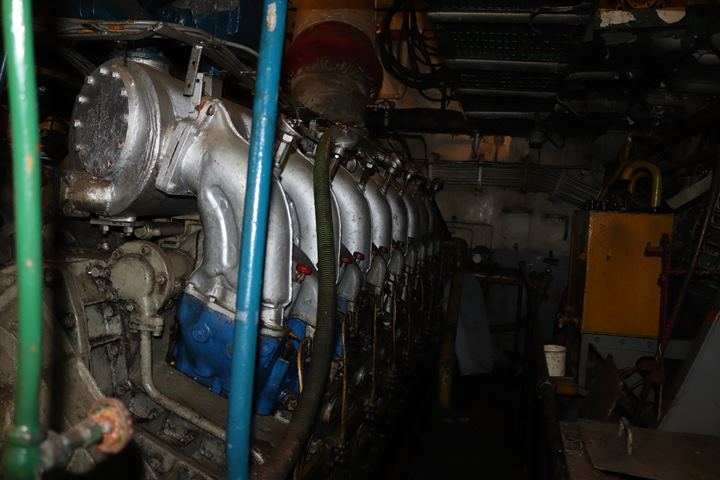
This is the un-restored sixteen cylinder
Cleveland Diesel 16-268 main propulsion engine #1 in the forward engine
room. There was no visible data plate for it. Author's photo added
10-29-2017.
USS Croaker in Buffalo, NY:
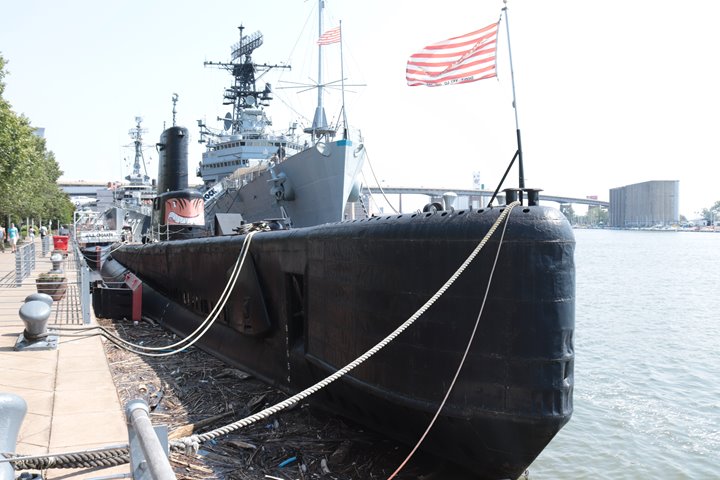
Author's photo added 10-29-2017.
Forward engine room:
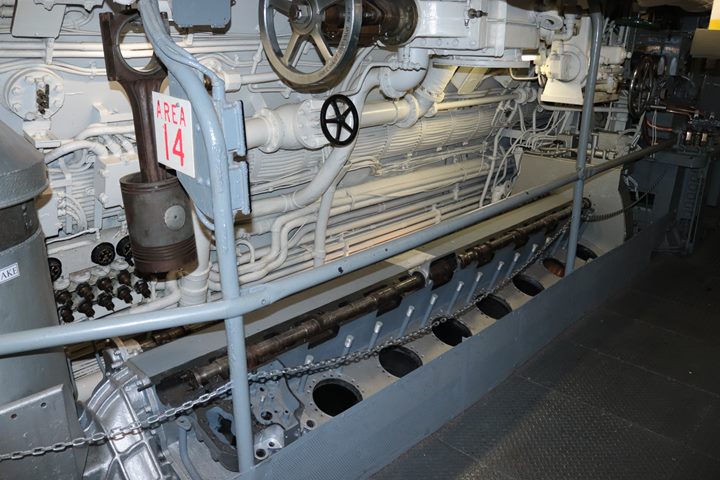
The forward engine room only has one engine
as the other was removed after World War Two. For display purposes the
heads have been removed on the remaining engine facing the walkway
allowing visitors to obtain a better view of the internal workings of
the 16-278. Author's photo added 10-29-2017.
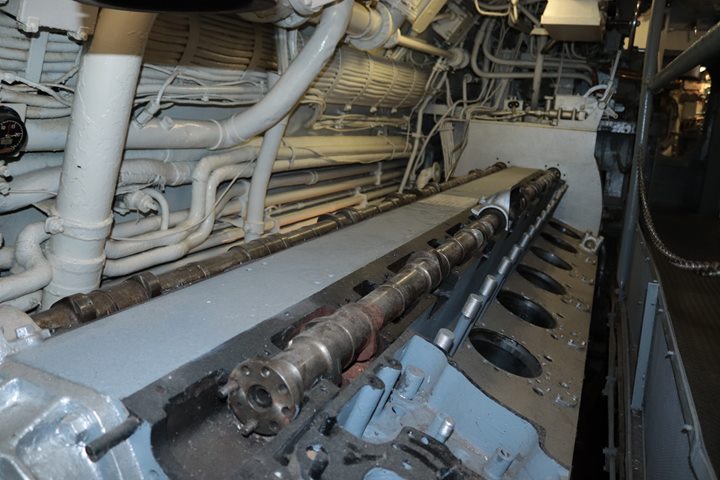
Author's photo added 10-29-2017.
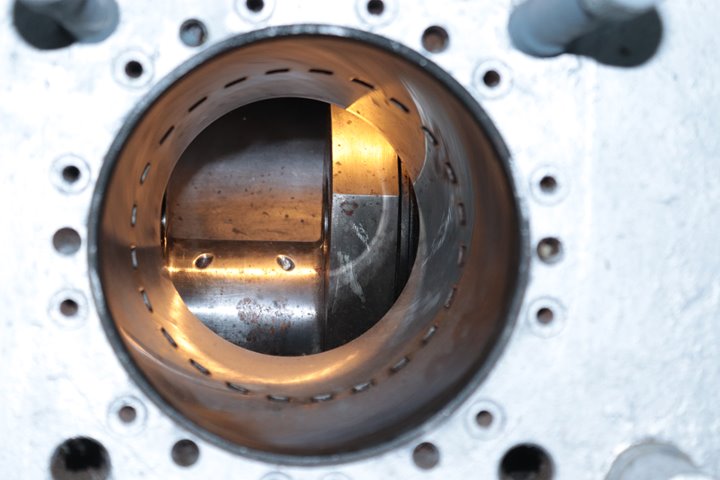
Author's photo added 10-29-2017.
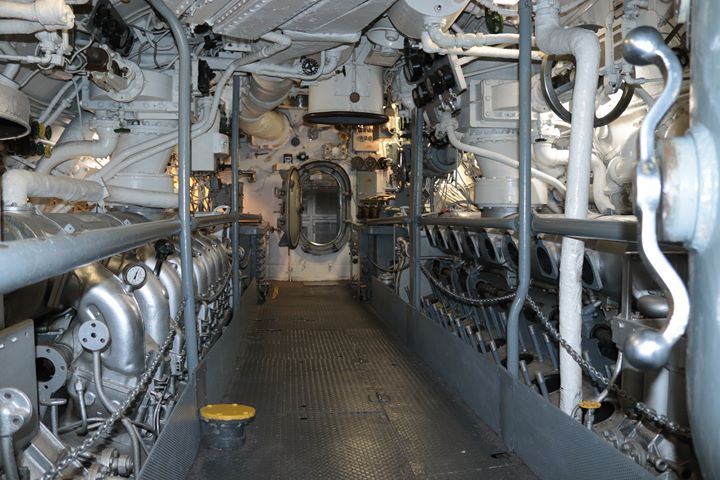
The aft engine room has both 16-278s
installed. Author's photo added 10-29-2017.
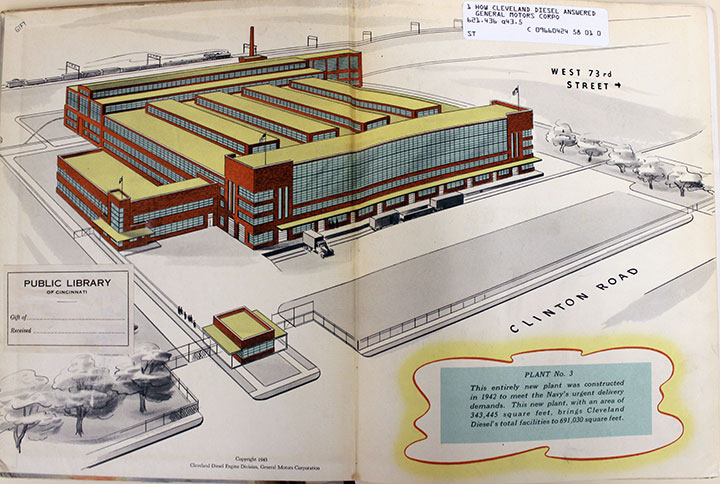
This drawing shows the Cleveland Diesel
Division Plant 3 at 8684 Clinton Road in Brooklyn, OH. The
building still stands
today, housing a
trucking company.
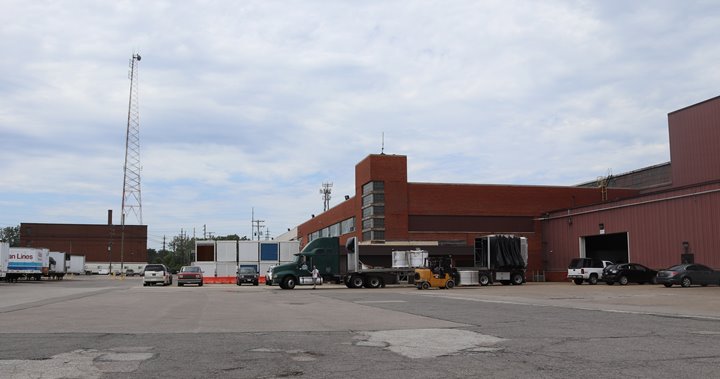
The distinctive corner staircase with
windows of the office area are still identifiable along with the glass
windows along the west side of the building. Author's photo added
10-29-2017.
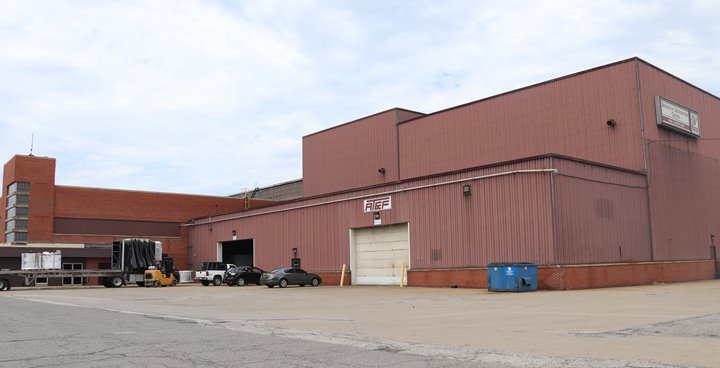
An extension to the plant was made towards
the Clinton Road. The original building that ran parallel to the
road is the highest structure in the photo. Author's photo added
10-29-2017.
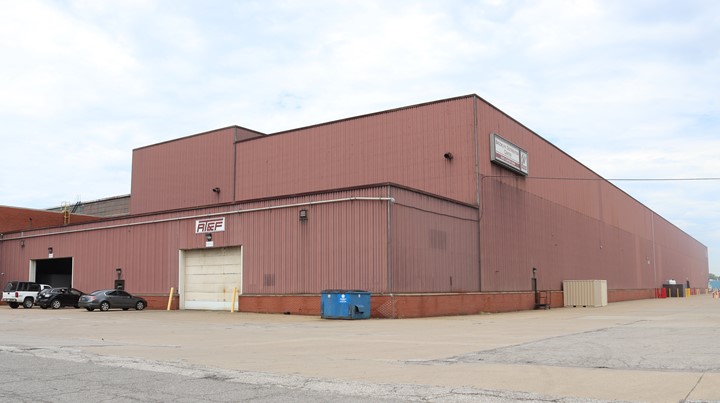
Author's photo added 10-29-2017.
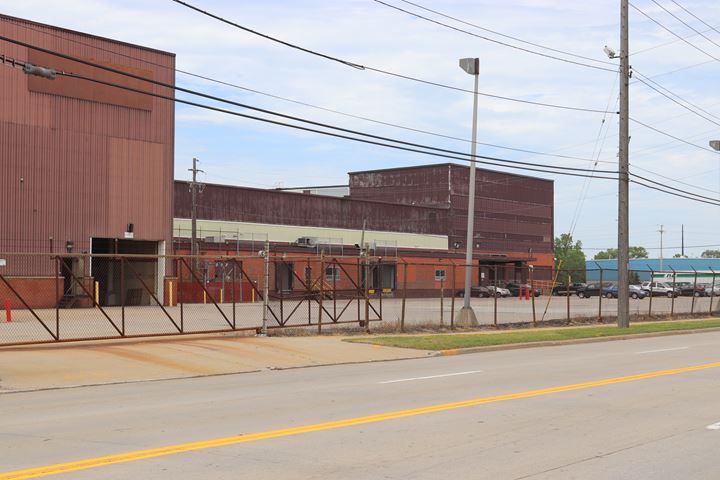
A large addition was also made at the east
end of the complex. Author's photo added 10-29-2017.
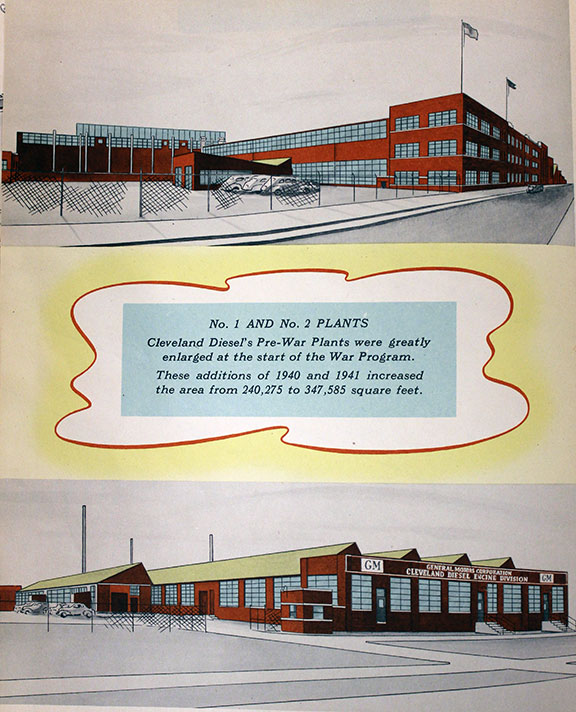
|


















































